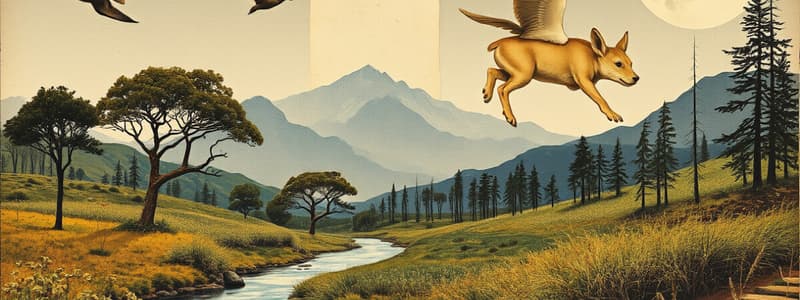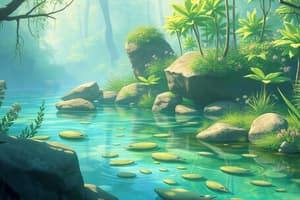Podcast
Questions and Answers
What is the primary source of energy in most ecosystems?
What is the primary source of energy in most ecosystems?
the sun
Who are the organisms most likely to belong to the same species?
Who are the organisms most likely to belong to the same species?
people at a football game
Which of the following statements about an organism's habitat is not true?
Which of the following statements about an organism's habitat is not true?
- Most organisms can survive if taken away from their habitat (correct)
- Most organisms thrive in their habitat
- Habitat influences behavior
- Habitat provides necessary resources
Some organisms are more likely to survive because they:
Some organisms are more likely to survive because they:
An organism is resistant to a chemical if it has:
An organism is resistant to a chemical if it has:
What is the process of two species changing genetically in response to long-term interactions called?
What is the process of two species changing genetically in response to long-term interactions called?
For evolution to occur in a population, individuals with a trait that is naturally selected for must:
For evolution to occur in a population, individuals with a trait that is naturally selected for must:
How many kingdoms do most scientists classify organisms into?
How many kingdoms do most scientists classify organisms into?
Which of the following animals is successful because it moves quickly, reproduces rapidly, and has a waterproof external skeleton?
Which of the following animals is successful because it moves quickly, reproduces rapidly, and has a waterproof external skeleton?
Which organisms convert nitrogen in the air into a form plants can use?
Which organisms convert nitrogen in the air into a form plants can use?
Most land animals depend on angiosperms for:
Most land animals depend on angiosperms for:
Which factors describe soil and temperature in an ecosystem?
Which factors describe soil and temperature in an ecosystem?
What best describes a population?
What best describes a population?
One way that bacteria and fungi are important to the environment is that they:
One way that bacteria and fungi are important to the environment is that they:
Which of the following is not a biotic factor in an ecosystem?
Which of the following is not a biotic factor in an ecosystem?
Single-celled organisms with cell walls but no nuclei are called:
Single-celled organisms with cell walls but no nuclei are called:
Which two kingdoms contain organisms that can use energy from the sun to make food?
Which two kingdoms contain organisms that can use energy from the sun to make food?
Which of the following characteristics is usually shared by bacteria, fungi, and plants?
Which of the following characteristics is usually shared by bacteria, fungi, and plants?
A gymnosperm is a(n):
A gymnosperm is a(n):
If an insect can no longer be killed by a particular insecticide, it has developed a(n) _______ to the chemical.
If an insect can no longer be killed by a particular insecticide, it has developed a(n) _______ to the chemical.
Most bacteria belong to the kingdom:
Most bacteria belong to the kingdom:
The initial source of food in most ocean and freshwater ecosystems is _____
The initial source of food in most ocean and freshwater ecosystems is _____
The initial source of food in most land ecosystems is _____
The initial source of food in most land ecosystems is _____
Pine trees and other conifers are classified as _____ because they are woody plants, the seeds of which are not enclosed in fruits.
Pine trees and other conifers are classified as _____ because they are woody plants, the seeds of which are not enclosed in fruits.
The living and once living parts of an ecosystem, including all the plants and animals, are _____ factors in the ecosystem.
The living and once living parts of an ecosystem, including all the plants and animals, are _____ factors in the ecosystem.
The nonliving parts of an ecosystem, such as rocks, light, air, and temperature, are _____ factors in the ecosystem.
The nonliving parts of an ecosystem, such as rocks, light, air, and temperature, are _____ factors in the ecosystem.
The place where an organism lives and has the resources it needs is called its:
The place where an organism lives and has the resources it needs is called its:
Darwin proposed that _______ is the mechanism for ________, the change in the genetic characteristics of a population from one generation to the next.
Darwin proposed that _______ is the mechanism for ________, the change in the genetic characteristics of a population from one generation to the next.
An inherited trait that increases an organism's chance of survival and reproduction in a certain environment is a(n) _____
An inherited trait that increases an organism's chance of survival and reproduction in a certain environment is a(n) _____
Bacteria are members of the _______ or _______ kingdoms.
Bacteria are members of the _______ or _______ kingdoms.
Unlike other organisms, _____ do not have cell nuclei.
Unlike other organisms, _____ do not have cell nuclei.
Yeasts that make bread rise belong to the _____ kingdom.
Yeasts that make bread rise belong to the _____ kingdom.
The one-celled organisms that cause malaria belong to the _____ kingdom.
The one-celled organisms that cause malaria belong to the _____ kingdom.
Many-celled organisms that have cell walls and make their own food are known as:
Many-celled organisms that have cell walls and make their own food are known as:
Match the two groups of plants based on their seed production:
Match the two groups of plants based on their seed production:
Animals that lack backbones are called:
Animals that lack backbones are called:
Animals that have backbones are called:
Animals that have backbones are called:
Athlete's foot is a disease caused by:
Athlete's foot is a disease caused by:
Create your own definition of community using your local community as an example.
Create your own definition of community using your local community as an example.
Flashcards
Main Energy Source
Main Energy Source
Most ecosystems get their energy from this source.
What is a population?
What is a population?
Members of the same species living in a specific location at the same time.
What is a Habitat?
What is a Habitat?
The natural place where an organism lives and thrives.
What is Natural Selection?
What is Natural Selection?
Signup and view all the flashcards
What is Coevolution?
What is Coevolution?
Signup and view all the flashcards
What are Kingdoms?
What are Kingdoms?
Signup and view all the flashcards
What are Bacteria?
What are Bacteria?
Signup and view all the flashcards
What are Fungi?
What are Fungi?
Signup and view all the flashcards
What are Angiosperms?
What are Angiosperms?
Signup and view all the flashcards
What is Phytoplankton?
What is Phytoplankton?
Signup and view all the flashcards
What is Adaptation?
What is Adaptation?
Signup and view all the flashcards
What are Biotic Factors?
What are Biotic Factors?
Signup and view all the flashcards
What are Abiotic Factors?
What are Abiotic Factors?
Signup and view all the flashcards
What are Invertebrates?
What are Invertebrates?
Signup and view all the flashcards
What are Vertebrates?
What are Vertebrates?
Signup and view all the flashcards
What is a Community?
What is a Community?
Signup and view all the flashcards
Study Notes
Energy Sources in Ecosystems
- Most ecosystems derive their energy primarily from the sun.
Species and Population Dynamics
- Organisms most likely belonging to the same species may be seen together, like people at a football game.
- A population is defined as members of the same species living in a specific location at the same time.
Habitat and Survival
- Organisms generally cannot survive if removed from their natural habitat.
- Some organisms thrive due to specific physical traits, inherited behaviors, or a lack of certain traits.
Evolution and Natural Selection
- Natural selection favors individuals with advantageous traits, who must reproduce for evolution to occur.
- Coevolution occurs when two species change genetically due to long-term interactions.
Organism Classification
- Scientists classify life into six kingdoms, including eubacteria and archaebacteria.
- Organisms capable of photosynthesis are found in the protist and plant kingdoms.
Bacteria and Fungi
- Bacteria play a crucial role in ecosystems by breaking down dead organisms.
- Bacteria are categorized as single-celled organisms without nuclei, while fungi, such as yeasts, belong to a separate kingdom.
Plant Types
- Angiosperms and gymnosperms are the two main groups of plants; gymnosperms bear seeds not enclosed in fruits, while angiosperms produce seeds within fruits.
- Most land animals rely on angiosperms for food.
Food Sources in Ecosystems
- Phytoplankton and algae serve as the foundational food source in most aquatic ecosystems, while angiosperms are primary for terrestrial ecosystems.
Organism Adaptations
- Resistance to chemicals, such as insecticides, signifies that an organism has adapted genetically and developed protective traits.
- An adaptation is an inherited trait that enhances an organism's chances of survival and reproduction in its environment.
Ecological Factors
- Biotic factors encompass all living or once-living components of an ecosystem, including plants and animals.
- Abiotic factors include nonliving elements like air, soil, temperature, and light.
Invertebrates and Vertebrates
- Animals without backbones are classified as invertebrates, while those with backbones are known as vertebrates.
Community Dynamics
- A community consists of multiple populations, including various organisms such as people, pets, insects, and plants, all interacting within a particular area.
Diseases and their Origins
- Athlete's foot is a fungal infection, illustrating how fungi can impact human health.
Studying That Suits You
Use AI to generate personalized quizzes and flashcards to suit your learning preferences.




